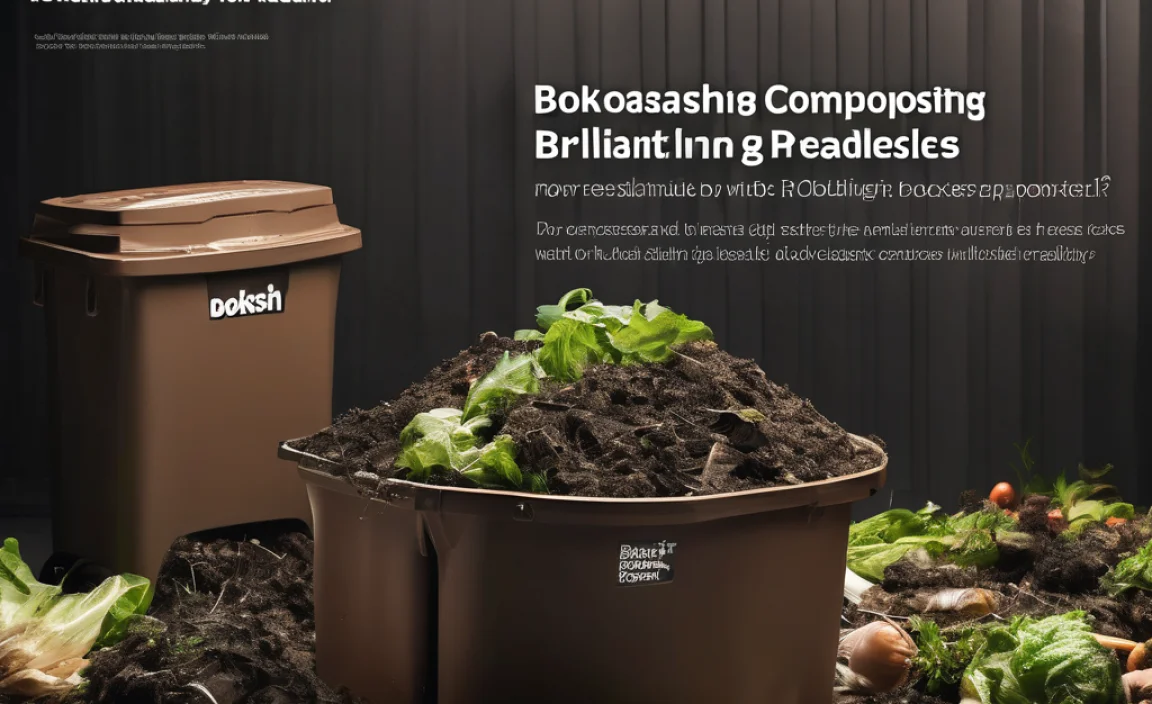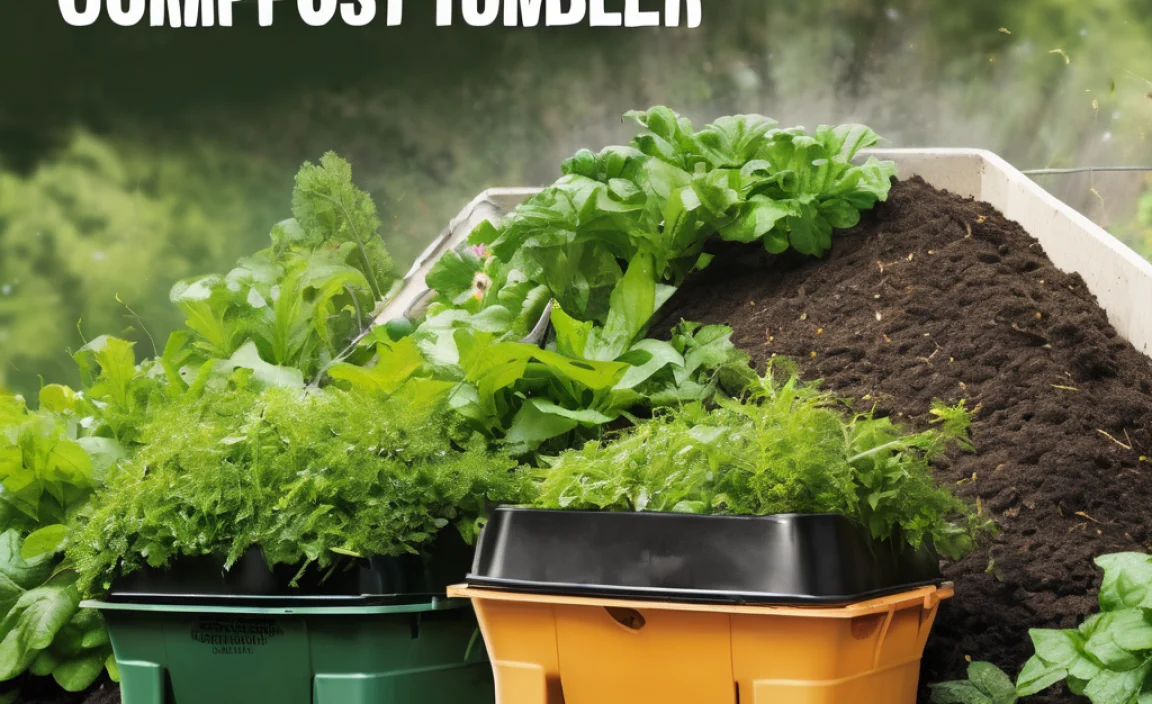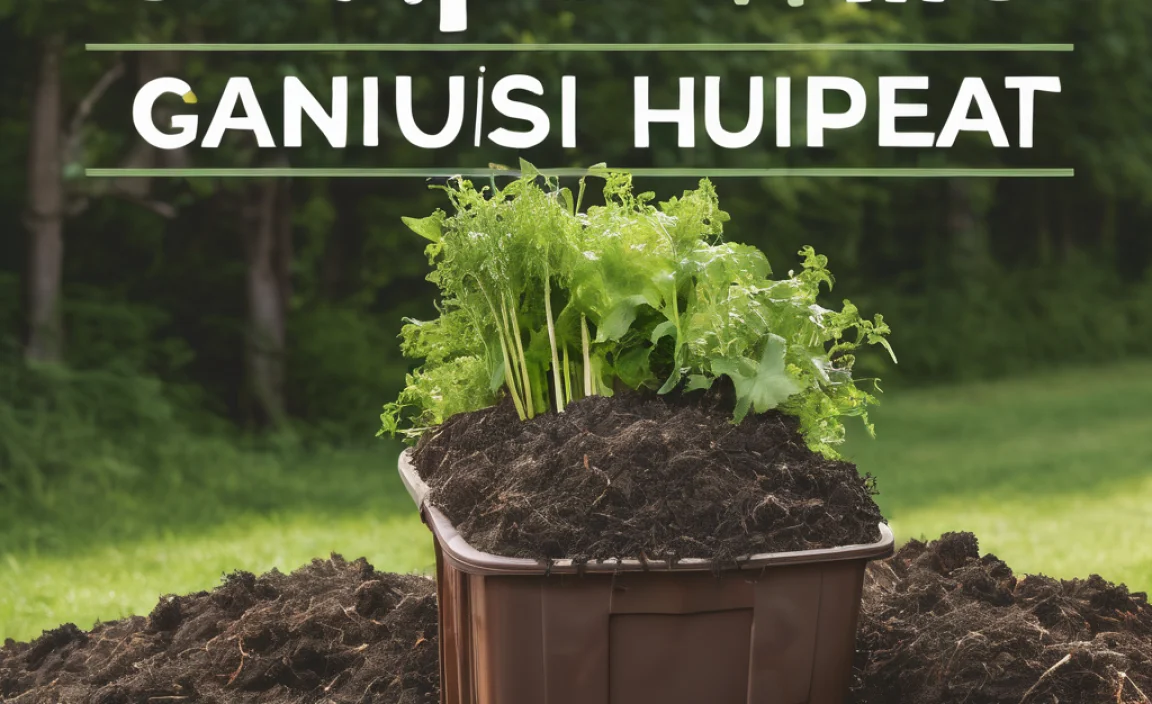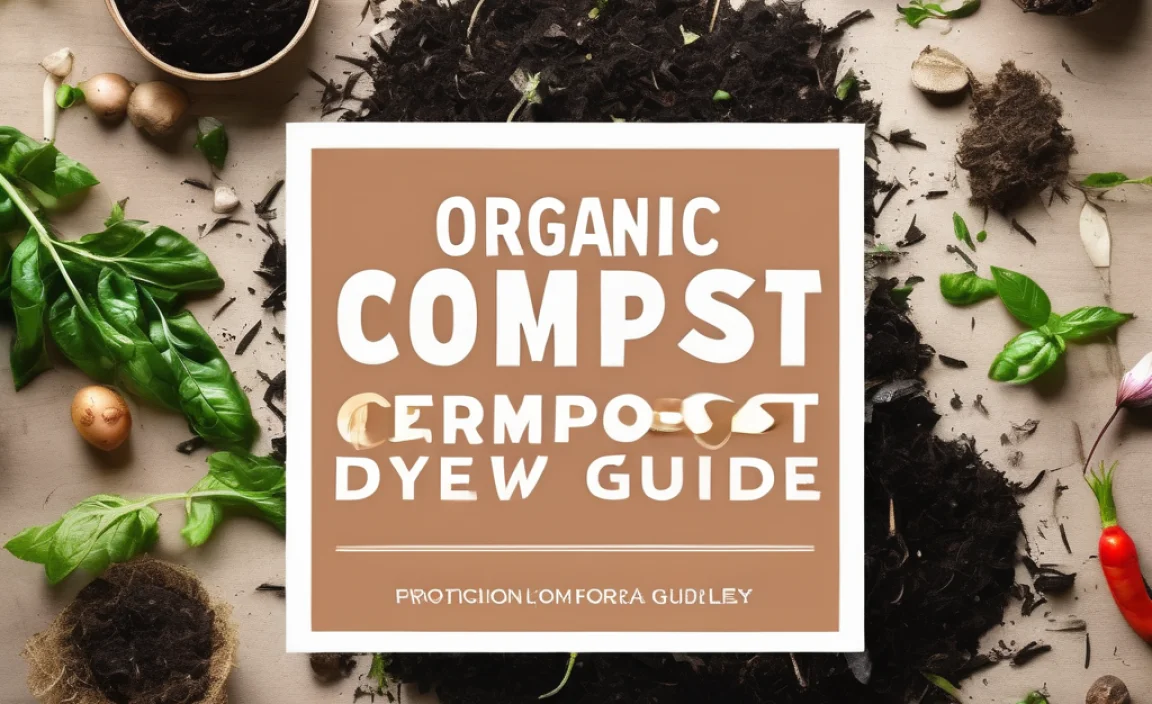Thinking about composting but not sure if it’s worth the effort? You’re not alone! Many people wonder if a compost bin is truly essential for their home. It might seem like just another thing to manage. But what if I told you that a simple bin could make a huge difference? It’s easier than you think. Let’s break down the amazing benefits of a compost bin and why it’s a game-changer for your garden and the planet. Get ready to learn how to turn scraps into garden gold!
Compost Bin Benefits: Why They’re More Than Just a Box
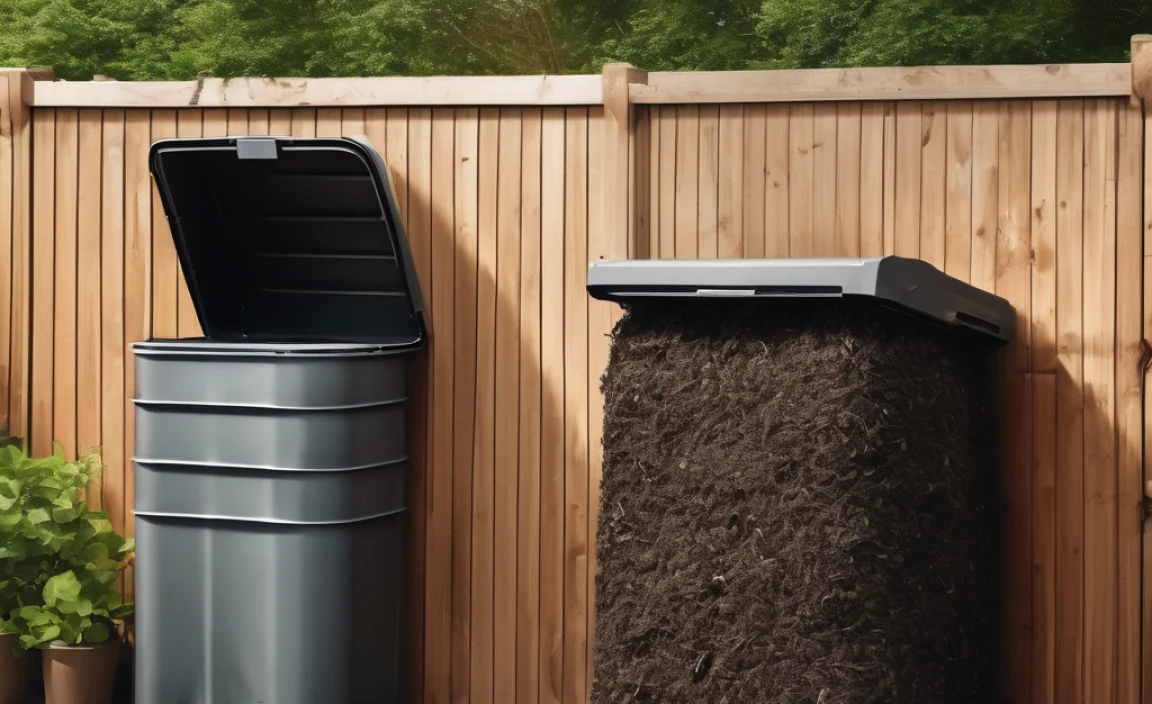
Hey neighbors! Troy D Harn here from TopChooser. If you’re anything like me, you like things to be simple, practical, and effective. That’s exactly why I want to talk about compost bins. You might see them in gardens and think, “Is that really necessary?” I’m here to tell you, with absolute certainty, YES! A compost bin isn’t just a trendy gardening accessory; it’s a powerful tool that offers a ton of benefits for your home, your garden, and even the environment. Let’s dig into why having one is practically essential.
What Exactly is Composting?
Before we dive deep into the benefits, let’s quickly cover what composting is. Think of it as nature’s recycling program. Composting is the process of breaking down organic materials – like food scraps and yard waste – into a nutrient-rich soil amendment called compost. This “black gold” is amazing for your plants. It’s essentially taking things that would otherwise end up in a landfill and turning them into something incredibly valuable.
The Top Compost Bin Benefits You Can’t Ignore
So, why go through the little bit of effort to set up a compost bin? The rewards are substantial. They go beyond just reducing waste. Let’s explore the proven essential benefits:
1. Supercharges Your Soil Health
This is arguably the biggest win. Compost is like a multivitamin for your soil. When you add compost, you’re not just adding nutrients; you’re improving the soil’s structure.
- Better Water Retention: Compost acts like a sponge, helping your soil hold onto water. This means you’ll need to water your plants less, which is a huge time and water saver.
- Improved Drainage: For clay soils that tend to get waterlogged, compost creates channels, allowing excess water to drain away. This prevents root rot.
- Enhanced Aeration: Compost loosens compacted soil, allowing air and water to reach plant roots more easily. Happy roots mean healthier plants!
- Nutrient Boost: Compost is packed with essential nutrients that plants need to thrive, like nitrogen, phosphorus, and potassium. It feeds your plants naturally.
- Introduces Beneficial Microbes: Healthy soil isn’t just about minerals; it’s alive! Compost introduces billions of beneficial bacteria, fungi, and other microorganisms that help plants absorb nutrients and fight off diseases.
Think of it this way: instead of buying expensive soil amendments or fertilizers, you’re creating your own, tailor-made for your garden, for free!
2. Reduces Your Trash Footprint (and Landfill Waste!)
Did you know that food scraps and yard waste make up a significant portion of what we throw away? According to the U.S. Environmental Protection Agency (EPA), yard trimmings and food scraps together constitute more than 30 percent of what we discard. When this organic material ends up in landfills, it doesn’t decompose nicely. Instead, it breaks down anaerobically (without oxygen), producing methane, a potent greenhouse gas that contributes to climate change.
By composting these materials at home, you divert them from landfills. This is a tangible way you can make a positive environmental impact right from your backyard. It’s a simple act with far-reaching ecological benefits.
3. Saves You Money
Let’s talk about the practical side – your wallet! Composting can lead to significant cost savings:
- Less Fertilizer Needed: As mentioned, compost is rich in nutrients. This can drastically reduce or even eliminate your need to buy synthetic fertilizers, which can be expensive.
- Fewer Soil Amendments: If your soil is poor, you often need to buy topsoil or other amendments. Compost essentially acts as these, improving soil quality for free long-term.
- Reduced Bagging of Yard Waste: If your municipality charges for yard waste pickup, composting means less waste to bag and less money spent on those special bags.
- Healthier Plants, Bigger Harvests: When your garden thrives thanks to nutrient-rich compost, you’re more likely to enjoy abundant harvests of vegetables and fruits, saving money on groceries.
It’s a win-win: good for the earth and good for your budget!
4. Complements Your Garden Plants Beautifully
Your plants will thank you. Compost provides a slow, steady release of nutrients, which is much better for plants than the quick, intense burst from synthetic fertilizers. This gradual feeding helps prevent nutrient burn and supports sustained growth.
- Promotes Stronger Root Development: Healthy soil structure encouraged by compost leads to deeper, more robust root systems.
- Boosts Disease Resistance: Plants that are well-nourished with compost are generally healthier and have a better ability to fend off pests and diseases.
- Improves Overall Plant Vigor: You’ll notice lusher foliage, more vibrant blooms, and more productive fruiting or vegetable yields.
It’s like giving your plants the best possible foundation to grow and flourish.
5. Decreases Reliance on Chemical Fertilizers and Pesticides
Many commercial fertilizers and pesticides can have negative impacts on the environment, polluting waterways and harming beneficial insects and soil organisms. Compost offers a natural alternative.
- Natural Pest Deterrent: Healthy soil and robust plants are less attractive to pests. Some studies even suggest compost can suppress certain soil-borne diseases.
- Reduces Chemical Runoff: By improving soil structure and providing nutrients naturally, you decrease the need for harsh chemicals, which can leach into groundwater and local streams.
Choosing compost is a step towards a more organic and sustainable gardening practice.
6. Conserves Water
We touched on this, but it’s worth emphasizing. The water-retention capabilities of compost are remarkable. A report by the Garden Myths website notes that compost can hold up to four times its weight in water.
This means that your garden soil, enriched with compost, acts like a sponge. It absorbs and holds onto moisture, releasing it slowly to the plant roots as needed. This significantly reduces how often you need to water, which is crucial in dry climates or during hot summer months. Less watering means less water consumption and lower water bills.
7. Improves Soil Structure Over Time
Whether you have heavy clay soil that’s hard to dig or sandy soil that drains too quickly, compost is your best friend. Over time, regular additions of compost will transform your soil:
- Clay Soils: Compost helps break up dense clay particles, creating air pockets and improving drainage and workability.
- Sandy Soils: Compost acts as a binder, helping sandy soil retain moisture and nutrients.
- General Improvement: For most soil types, compost adds aeration, making it easier for roots to penetrate and grow.
It’s a long-term investment in the health and vitality of your garden landscape.
Choosing the Right Compost Bin for You
Now that you’re convinced about the benefits, you might be wondering which type of compost bin is best. There are several popular options, and the “best” one really depends on your space, how much waste you produce, and your personal preference. Here’s a quick rundown:
| Bin Type | Pros | Cons | Best For |
|---|---|---|---|
| Open Piles | Easiest to start, no cost for the bin itself, can handle large volumes. | Can look messy, may attract pests if not managed well, slower decomposition. | Large yards, people with lots of yard waste, budget-conscious. |
| Stationary Bins (Plastic/Wood) | Keeps materials contained, often have lids to deter pests, relatively neat appearance. | Can be harder to turn/aerate, require some assembly or purchase, fixed capacity. | Suburban yards, moderate waste production, those wanting a tidy look. |
| Tumbler Bins | Excellent for turning/aerating, speeds up composting time significantly, contained and pest-resistant. | Higher cost, limited capacity (you fill it, then wait), can get heavy when full. | Apartment dwellers with balconies, small yards, those wanting fastest results. |
| Worm Bins (Vermicomposting) | Great for food scraps, produces very rich compost (“worm castings”), can be done indoors. | Cannot handle yard waste, requires managing live worms, specific temperature needs. | Apartment dwellers, avid cooks, those wanting super-rich fertilizer. |
When I first started, I went with a simple stationary bin. It was easy to set up and kept things looking tidy on my patio. If you have a lot of yard waste from trees, an open pile might be best. For apartment dwellers, a tumbler or worm bin is a lifesaver.
What You Can (and Can’t) Compost
Getting your compost recipe right is key to success. Here’s a general guide to what works well:
Good Stuff (Greens – Nitrogen Rich)
- Fruit and vegetable scraps
- Coffee grounds and filters
- Tea bags
- Grass clippings (in moderation)
- Plant trimmings (non-diseased)
- Eggshells
Good Stuff (Browns – Carbon Rich)
- Dry leaves
- Shredded newspaper or cardboard (non-glossy)
- Straw or hay
- Wood chips or sawdust (untreated wood)
- Pine needles
Stuff to Avoid (Mostly!)
- Meat, fish, and dairy products (can attract pests and create odors)
- Oily or greasy foods
- Diseased plants or weed seeds (can spread problems)
- Pet waste (dog and cat feces can contain pathogens)
- Treated wood or charcoal ash
- Synthetics or plastics
A good rule of thumb for balancing your compost is to aim for roughly a 2:1 or 3:1 ratio of Browns to Greens. This means more carbon-rich “browns” than nitrogen-rich “greens.” This balance helps prevent your compost from getting too wet and smelly.
Getting Started: A Simple Approach
Starting a compost bin is less intimidating than it sounds. Here’s a basic, step-by-step guide for a common stationary bin:
-
Choose Your Location: Pick a spot that’s easily accessible, has decent drainage, and gets some sun (but not scorching afternoon sun all day). Avoid placing it too close to your house or your neighbor’s fence.
-
Set Up Your Bin: Assemble your bin according to the manufacturer’s instructions. If you’re building one, ensure it’s sturdy and allows for some airflow.
-
Start with a Layer of Browns: Begin with a base layer of dry leaves, shredded cardboard, or straw. This helps with aeration from the bottom.
-
Add Your Greens: Start adding your kitchen scraps (chopped up smaller speeds things up!) and garden trimmings. Try to bury food scraps slightly within the brown material to reduce odors and deter pests.
-
Balance Greens and Browns: As you add more waste, consciously add more “brown” materials than “green” materials over time. A good mix is key!
-
Aerate: Regularly turn your compost pile. This can be done with a pitchfork or a compost aerator tool. Turning introduces oxygen, which speeds up decomposition and prevents a stinky mess. Aim to turn it once a week or every couple of weeks.
-
Keep it Moist: Your compost should be as damp as a wrung-out sponge. If it’s too dry, add water. If it’s too wet, add more brown materials and turn it.
-
Harvest Your Compost: Depending on the method and materials, compost can be ready in anywhere from a few months to a year. You’ll know it’s ready when it’s dark, crumbly, and smells earthy (not unpleasant). You can then sift it and add it to your garden beds!
For more detailed composting guides, check out resources from your local extension office or universities like NC State University Extension. They offer fantastic, research-backed tips.
Can a Compost Bin Really Make That Much Difference?
Yes! The impact of a compost bin, even a small one, is significant. On a household level, it directly diverts waste from landfills, reduces your need for store-bought garden inputs, and leads to a healthier, more productive garden. On a larger scale, widespread composting helps reduce methane emissions, conserves water, and promotes a more circular economy where waste is a resource. It’s a simple action with powerful ripple effects.
Quick Summary of Compost Bin Benefits
Here’s a quick recap of why a compost bin is a proven essential:
- Soil Enrichment: Creates nutrient-dense, well-structured soil.
- Waste Reduction: Diverts organic materials from landfills.
- Cost Savings: Reduces spending on fertilizers, soil amendments, and sometimes water.
- Plant Health: Promotes stronger, more disease-resistant plants.
- Environmental Impact: Decreases greenhouse gas emissions and chemical use.
- Water Conservation: Improves soil’s ability to hold water.
- Soil Improvement: Enhances drainage and aeration for all soil types.
Frequently Asked Questions about Compost Bins
Let’s tackle some common questions beginners have.
Q1: How long does it take to make compost?
A: It really varies! Depending on the bin type, the materials you use, and how often you turn it, compost can be ready in as little as 3-6 months for fast methods like tumblers or up to a year or more for slower, layered piles.
Q2: My compost bin smells bad. What did I do wrong?
A: A stinky compost bin usually means it’s too wet and lacks oxygen. This often happens when there are too many “green” (nitrogen-rich) materials and not enough “brown” (carbon-rich) materials. Try adding more shredded cardboard, dry leaves, or straw, and turn the pile well to introduce air. Leave the lid slightly ajar if it’s a sealed bin.
Q3: Do I need a special compost bin, or can I just make a pile?
A: You absolutely can just make a pile! An open pile works well, especially if you have a lot of yard waste. Bins are helpful for keeping things neater, deterring pests, retaining moisture, and can sometimes speed up the process. But for starting out, a simple pile in a corner of your yard is perfectly fine.
Q4: What’s the difference between “greens” and “browns”?
A: “Greens” are nitrogen-rich materials like fruit and vegetable scraps, grass clippings, and coffee grounds. “Browns” are carbon-rich materials like dry leaves, shredded newspaper, cardboard, straw, and wood chips. A good balance (more browns than greens) is essential for healthy composting.
Q5: Can I compost kitchen scraps like meat and dairy?
A: It’s generally best to avoid meat, fish, dairy products, and oily foods. While they will eventually break down, they can attract pests like rodents and flies, and can create unpleasant odors. Stick to plant-based kitchen scraps for easier, cleaner composting.
Q6: How do I know when my compost is ready to use?
A: Finished compost will be dark brown or black, crumbly in texture, and will smell earthy, like a forest
.lwrp.link-whisper-related-posts{
margin-top: 40px;
margin-bottom: 30px;
}
.lwrp .lwrp-title{
}.lwrp .lwrp-description{
}
.lwrp .lwrp-list-container{
}
.lwrp .lwrp-list-multi-container{
display: flex;
}
.lwrp .lwrp-list-double{
width: 48%;
}
.lwrp .lwrp-list-triple{
width: 32%;
}
.lwrp .lwrp-list-row-container{
display: flex;
justify-content: space-between;
}
.lwrp .lwrp-list-row-container .lwrp-list-item{
width: calc(25% – 20px);
}
.lwrp .lwrp-list-item:not(.lwrp-no-posts-message-item){
max-width: 150px;
}
.lwrp .lwrp-list-item img{
max-width: 100%;
height: auto;
object-fit: cover;
aspect-ratio: 1 / 1;
}
.lwrp .lwrp-list-item.lwrp-empty-list-item{
background: initial !important;
}
.lwrp .lwrp-list-item .lwrp-list-link .lwrp-list-link-title-text,
.lwrp .lwrp-list-item .lwrp-list-no-posts-message{
}@media screen and (max-width: 480px) {
.lwrp.link-whisper-related-posts{
}
.lwrp .lwrp-title{
}.lwrp .lwrp-description{
}
.lwrp .lwrp-list-multi-container{
flex-direction: column;
}
.lwrp .lwrp-list-multi-container ul.lwrp-list{
margin-top: 0px;
margin-bottom: 0px;
padding-top: 0px;
padding-bottom: 0px;
}
.lwrp .lwrp-list-double,
.lwrp .lwrp-list-triple{
width: 100%;
}
.lwrp .lwrp-list-row-container{
justify-content: initial;
flex-direction: column;
}
.lwrp .lwrp-list-row-container .lwrp-list-item{
width: 100%;
}
.lwrp .lwrp-list-item:not(.lwrp-no-posts-message-item){
max-width: initial;
}
.lwrp .lwrp-list-item .lwrp-list-link .lwrp-list-link-title-text,
.lwrp .lwrp-list-item .lwrp-list-no-posts-message{
};
}

I am passionate about home engineering. I specialize in designing, installing, and maintaining heating, ventilation, and air conditioning systems. My goal is to help people stay comfortable in their homes all year long.

